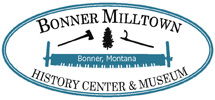 The confluence of the Clark Fork and Blackfoot Rivers is bordered by the several communities. Closest to the confluence itself is Milltown; north of the Clark Fork and west of the Blackfoot lie West Riverside and Pine Grove; north of the Clark Fork and east of the Blackfoot is Bonner and Piltzville.
The confluence of the Clark Fork and Blackfoot Rivers is bordered by the several communities. Closest to the confluence itself is Milltown; north of the Clark Fork and west of the Blackfoot lie West Riverside and Pine Grove; north of the Clark Fork and east of the Blackfoot is Bonner and Piltzville.
For thousands of years the rivers now known as the Big Blackfoot and Clark Fork flowed to the sea without human intervention save for occasional visits by native tribes and early explorers.
In the mid-1800s that changed. In 1864 Montana became a territory and Missoula Mills, now known as just Missoula, was founded.
Entrepreneurs recognized the great merchandizing potential of the area, established partnerships, and located in the new town of Missoula. Those interests soon expanded to include lumbering ventures to meet the demands of the railroad and the mines in Butte.
Names such as Hammond and Bonner, two of the partners in the Montana Improvement Company, became forever linked to the history of the area when, in June, 1886, the first logs were sawed at new, permanent mill.
The land on which the mill and town of Bonner was built was allegedly purchased from settler Hiram Farr for $100 and a cow. Gladys Peterson in A Grass Roots Tribute: The Story of Bonner, Montana, (1976) wrote that “Bonner, Montana can make no claim for remarkable size or remarkable growth. After 90 years of existence it possesses only 45 houses and a population of about 150 persons. Yet this town which has no mayor, no town hall, nor any apparent local government continues to function in the role it was assigned at its birth, the role of a company town.”
The company town was built in part to have supervisors near the mill 24/7. Mill workers and loggers including French Canadians, Finns, Swedes, and Norwegians had to settle nearby. Riverside, now Milltown, a part of John McCormick’s ranch, was neatly divided into lots leased to immigrant workers.
By 1910, land ownership became an option when Barbara Zaugg subdivided West Riverside across the Blackfoot from Riverside (Milltown). The establishing of the Western Lumber Company on the Clark Fork River increased West Riverside’s population.
Piltzville, to the east, and Pine Grove, to the west, offered farming opportunities as well as more opportunities for land ownership for mill workers.
